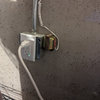Is my house really grounded?
drmeow3
15 years ago
Related Stories

GROUND COVERSGround Force: 10 Top Ground Covers for Your Garden
Protect your soil from weeds and drought this summer with a living mulch of ground covers
Full Story
ARCHITECTUREStilt Houses: 10 Reasons to Get Your House Off the Ground
Here are 10 homes that raise the stakes, plus advice on when you might want to do the same
Full Story
ARCHITECTUREHow Will Your New House Meet the Ground?
The choices you make early on affect the whole project. Here’s how to make your house beautiful from the foundation up
Full Story
HOUZZ TOURSHouzz Tour: Earthiness Grounds a Contemporary Louisiana Home
Generous wood and thoughtful design on a 32-acre site, pond included, make for a warm-looking home that naturally fits its owners
Full Story
CONTEMPORARY HOMESHouzz Tour: A Brave Addition Breaks New Ground
An Edwardian cottage gets a radical renovation with a dynamic deck that wraps a couple and 2 children in style
Full Story
GARDENING GUIDES10 Native Ground Covers for Southwestern Landscapes
Create a carpet of color in your landscape with one or more of these sun-loving plants
Full Story
BASEMENTSBasement of the Week: From Dumping Ground to Family Hangout
With a lounge, home office and playroom, everyone's covered in this renovated Seattle basement
Full Story
LANDSCAPE DESIGN6 Great Ways With Garden Ground Covers
Use them as problem solvers, weed killers, color and texture providers ... ground cover plants have both practical and visual appeal
Full Story
DECORATING GUIDESNo Neutral Ground? Why the Color Camps Are So Opinionated
Can't we all just get along when it comes to color versus neutrals?
Full Story




skyline_electric
drmeow3Original Author
Related Discussions
I bough my birds a really nice home apprently!
Q
My first home: Am I over doing it really with size?
Q
above ground pools below ground- really?
Q
Do I really need a chimney liner in my 50 year old house?
Q
drmeow3Original Author
chris8796
hendricus
terribletom
petey_racer
drmeow3Original Author
drmeow3Original Author
brickeyee
terribletom
petey_racer
drmeow3Original Author
brickeyee
drmeow3Original Author
petey_racer
drmeow3Original Author
petey_racer
brickeyee
drmeow3Original Author
drmeow3Original Author
brickeyee
drmeow3Original Author